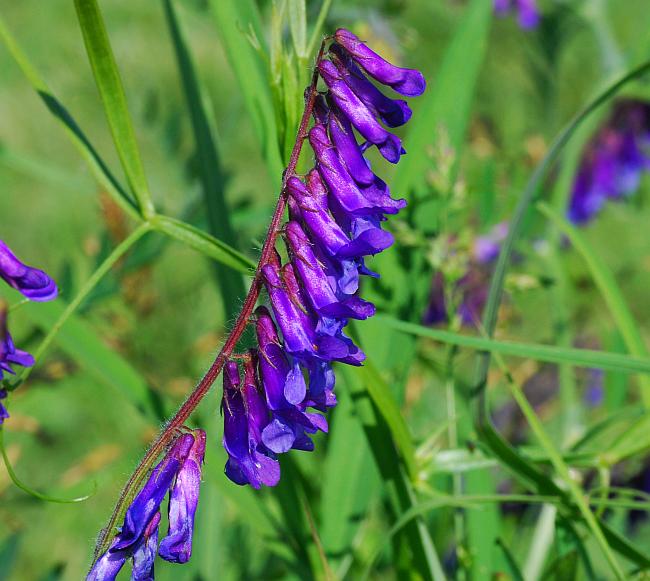Vicia villosa ssp. villosa
Woolly Vetch

Introduced
CC = *
CW = 5
MOC = 34
© SRTurner
Vicia villosa ssp. villosaWoolly Vetch | |
 |
Introduced CC = * CW = 5 MOC = 34 |
© SRTurner |
|
Family - Fabaceae/Faboideae Habit - Taprooted annual or biennial forb. Stems - Sprawling to clambering or climbing (by means of tendrils on leaves), to 1 m, moderately to densely pubescent with conspicuous, spreading hairs. Leaves - Alternate, even-pinnate, stipulate, with 12-18 leaflets, the petiole absent or to 3 mm long, the terminal tendrils branched. Stipules 5-8 mm long, lacking a glandular spot, with a narrowly triangular basal lobe, the margins otherwise entire. Leaflets 10-30 mm long, 2-6 mm wide, those of the lower leaves not strongly reduced, narrowly oblong-lanceolate to narrowly elliptic or linear, rounded to more commonly angled or tapered at the base, variously rounded to bluntly or sharply pointed at the tip, the midvein often extended as a minute, sharp point at the very tip, the surfaces moderately to densely pubescent.
Inflorescences - Axillary racemes, the stalk densely hairy, 3-9 cm long, the flowers 10-40, each with a stalk 1-2 mm long. Flowers nodding.
Flowers - Calyces often bluish-or purplish-tinged, the tube 2-3 mm long, the base strongly oblique and conspicuously pouched on 1 side, the attachment appearing lateral, the lobes 0.5-4.0 mm long, strongly unequal, the upper pair short and triangular to broadly triangular, the lowermost 2-4 mm long, much longer than the upper pair, narrowly triangular to lanceolate-triangular, or more or less hairlike above a short, triangular base, moderately to densely hairy. Corollas papilionaceous, 12-18 mm long, blue to purple or rarely pink or white, the keel and wings sometimes lighter than the banner, the banner bent or curved upward toward the tip, strongly curved around the wings and keel. Stamens with the fused portion 9-10 mm long, the free portion 1.5-3.0 mm long. Style with a dense ring of short hairs at the base and a patch of dense short hairs on the lower side near the tip.
Fruits - Compressed legumes 25-30 mm long, 7-10 mm wide, short-stalked, sometimes finely hairy when young, glabrous at maturity, straw-colored to light brown at maturity, 3-7-seeded. Seeds 3.5-5.0 mm long, dark reddish brown to greenish brown or nearly black, often with darker mottling, more or less circular in outline, not or only slightly flattened, the attachment scar not raised, dark brown, inconspicuous, extending less than 1/4 the circumference of the seed. Flowering - May - July. Habitat - Fields, pastures, levees, roadsides, railroads, open disturbed areas. Origin - Native to Europe. Lookalikes - V. villosa ssp. varia, V. americana. Other info. - This rather striking species is found in scattered locations throughout Missouri, often along roadsides, and in similarly scattered fashion throughout the continental U.S. It is probably more common than collection records indicate, as it tends to be ignored by many botanists. It is easily recognized by its showy inflorescences of numerous pendent flowers, which are usually purple. The plants typically clamber on other vegetation by means of tendrils. They can grow very aggressively and form large monospecific tangles of plants. Photographs taken at the Honey Creek Conservation Area, Andrew County, MO., 5-3-00, and in Swope Park, Jackson County, MO., 5-13-00 (DETenaglia); also at Shaw Nature Reserve, Franklin County, MO, 5-19-2007 (SRTurner). |